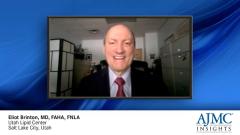
Childhood Diagnosis of HoFH
Seth Baum, MD, and Erin Michos, MD, MHS, discuss pediatric diagnosis of homozygous FH.
Episodes in this series

Seth Baum, MD: If we look specifically at the diagnosis of homozygous [Ho]FH [familial hypercholesterolemia] in children, there are additional complexities that go beyond making the diagnosis in adulthood. The most obvious one is, what a terrible diagnosis for a kid and his parents. These are children who, at the time of diagnosis, nearly 50% have established ASCVD [atherosclerotic cardiovascular disease] and they’re [younger than age] 10 years. There are children who have [died] from a heart attack. Children who have had bypass surgery before the age of 10. This is a disease we ordinarily think of as an adult disease when it presents or when it’s identified in childhood, it’s emotionally incredibly challenging. We also have issues with therapeutics; we don’t have perhaps the same number of therapeutics in childhood as we would in adulthood. And multiple drugs are required in this scenario. Another thing that was identified from the FH Foundation’s Cascade FH Registry was that the LDL [low-density lipoprotein] levels of children who are identified far exceed the LDL levels of adults when they’re identified. So, children had a median LDL level of 775 at the time of diagnosis while adults was 533. [That is] almost 250-mg/dL delta there, so, why is that? Well, that is probably because we’re identifying only the most severe of the children. We’re missing a lot of children who have [HoFH]. Part of the problem is that we’re not typically following the guidance of our pediatric guidelines and other guidelines, which are that any children of people with FH or children of parents with premature heart disease should have their LDLs checked at the age of 2. We require universal LDL screening between 9 and 11 but [if there is] a family history of FH or premature heart disease, we should be checking it too. If we did that, we’d identify all of these children at the age of 2. So, we’re really missing the boat there. And when we think about the fact that early diagnosis is critical, early treatment is critical, and aggressive treatment critical, we are missing a tremendous opportunity to diagnose [HoFH] at the proper time and to stave off cardiovascular events as we could. I’d also state that this is a genetic disease. And what does that mean? That means that these children are bathing in LDL in utero. And we’ve done studies that have measured LDL in utero. And LDL levels in these kids have been identified as over 500 mg/dL. So, the risk is accruing even prior to birth in these children with [HoFH].
Erin Michos, MD, MHS: It’s so important that patients with [HoFH] get diagnosed early in childhood. You know, as I mentioned, left untreated children as young as 4 years of age may suffer a heart attack or even sudden death. This really highlights the urgency to identify and treat patients with extremely high-risk conditions. So, first of all, I want them to be diagnosed early so that they’re able to survive to adulthood and be able to see me. These extreme elevations and LDL could be 4 to 5 times higher than in the general population. Some of the challenges are that it can be difficult to reach optimal LDL levels, especially in the pediatric population. Many multiple lipid-lowering medications are required at maximally tolerated doses but many have not been adequately studied in the pediatric population. Assuming the diagnosis is made at a young age, pravastatin is approved as young as the age of 8, the other statins not until age 10. Acetamide can also be considered in the pediatric population. PCSK 9 inhibitors, evolocumab is the one approved and homozygous FH and can be initiated as young as 10 and then even knock them out which we’ll talk more about has an FDA label for [HoFH] 12 years and older, but it’s currently undergoing urgent review by the FDA for evaluation of use in children ages 5 to 11. Hopefully, we’ll have some decisions on that. But yes, it’s very important that these children are treated early to help ward off and mitigate this early onset upper spot of cardiovascular disease because this really affects their long-term prognosis in terms of their freedom for morbidity and ultimately their survival.
Transcript edited for clarity.
Newsletter
Stay ahead of policy, cost, and value—subscribe to AJMC for expert insights at the intersection of clinical care and health economics.































































